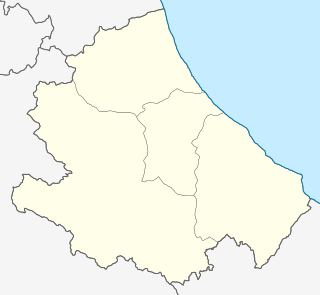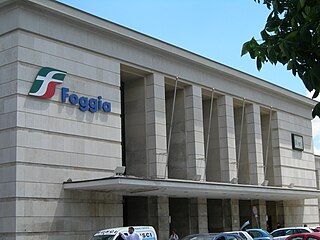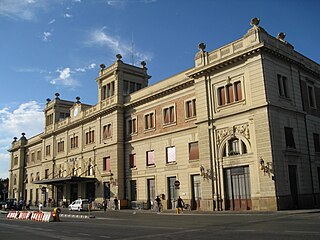
Italy has a well developed transport infrastructure. The Italian rail network is extensive, especially in the north, and it includes a high-speed rail network that joins the major cities of Italy from Naples through northern cities such as Milan and Turin. Italy has 2,507 people and 12.46 km2 per kilometer of rail track, giving Italy the world's 13th largest rail network.

Pescara is the capital city of the Province of Pescara, in the Abruzzo region of Italy. It is the most populated city in Abruzzo, with 119,217 (2018) residents. Located on the Adriatic coast at the mouth of the Aterno-Pescara River, the present-day municipality was formed in 1927 joining the municipalities of the old Pescara fortress, the part of the city to the south of the river, and Castellamare Adriatico, the part of the city to the north of the river. The surrounding area was formed into the province of Pescara.

Rail transport in Central America consists of several isolated railroad lines with freight or passenger service. The most famous one is the Panama Canal Railway, the oldest transcontinental railroad in the world, connecting Panama City with Colón since 1855. Other railroads in Belize, Guatemala, Honduras, El Salvador, Nicaragua, Costa Rica and Panama were built by private and public investors mainly to facilitate the transport of local agricultural produce to export markets and harbors. Their market share and profitability went into decline in the second half of the twentieth century and most lines have been decommissioned by the end of the 1990s. As of 2018, railroads operate locally in Honduras, Costa Rica and Panama only; all rail transport has been suspended in Belize, El Salvador, Guatemala and Nicaragua. The railways still operating do not cross national borders.

The General Manuel Belgrano Railway (FCGMB), named after the Argentine politician and military leader Manuel Belgrano, is a 1,000 mmmetre gauge railway and the longest of the Argentine system. It was one of the six State-owned Argentine railway companies formed after President Juan Perón's nationalisation of the railway network in 1948.

The General San Martín Railway (FCGSM), named after the former Argentine general José de San Martín, was one of the six state-owned Argentine railway companies formed after President Juan Perón's nationalisation of the railway network in 1948. The six companies were managed by Ferrocarriles Argentinos which was later broken up during the process of railway privatisation beginning in 1991 during Carlos Menem's presidency.

Pescara Centrale railway station, also known as Pescara railway station is the main railway station of Pescara. The station lies on the Adriatic line from Rimini to Lecce and the trans-Apennine line to Rome. It serves an average of 3.5 million people per year and is a 5-minute walk to the city's main street and to the beach.

Padova railway station, or Padua railway station, sometimes referred to as Padova Centrale, is the main station serving the city and comune of Padua, in the Veneto region, northeastern Italy.

Chieti railway station serves the city and comune of Chieti, in the region of Abruzzo, southern Italy. Opened in 1873, it forms part of the Rome–Sulmona–Pescara railway.

L'Aquila railway station serves the city and comune of L'Aquila, in the region of Abruzzo, southern Italy. Opened in 1875, it forms part of the Terni–Sulmona railway.

Taranto railway station is the main station serving the city and comune of Taranto, in the region of Apulia, southern Italy. Opened in 1868, it forms a junction between three main lines, from Bari, Brindisi and Reggio di Calabria, respectively. It is also a terminus of a secondary line, the Bari–Martina Franca–Taranto railway.

Lecce railway station serves the city and comune of Lecce, in the region of Apulia, Southern Italy. Opened in 1866, it is the southern terminus of the Adriatic Railway (Ancona–Lecce), and is also the terminus of two regional lines, the Martina Franca–Lecce railway and the Lecce–Otranto railway.

Barletta railway station is the main station serving the city and comune of Barletta, in the region of Apulia, southern Italy. Opened in 1864, it forms part of the Adriatic Railway (Ancona–Lecce), and is also a junction station for two other, regional, lines, the Barletta–Spinazzola railway, and the Bari–Barletta railway, operated by Ferrotramviaria.

Foggia railway station serves the city and comune of Foggia, in the region of Apulia, Southern Italy. Opened in 1864, it forms part of the Adriatic Railway (Ancona–Lecce), and is the terminus of the Naples–Foggia railway. It is also a junction for several other, secondary lines, namely the Foggia–Manfredonia, Lucera–Foggia and Foggia–Potenza railways.

Forlì railway station serves the city and comune of Forlì, in the region of Emilia-Romagna, northern Italy. Opened in 1926, it forms part of the Bologna–Ancona railway.

Ascoli Piceno railway station serves the town and comune of Ascoli Piceno, in the region of Marche, central Italy. Opened in 1886, it is the southwestern terminus of the San Benedetto del Tronto–Ascoli Piceno railway, a branch of the Adriatic railway.

Rimini railway station is the main station serving the city and comune of Rimini, in the region of Emilia-Romagna, northern Italy. Opened in 1861, it forms part of the Bologna–Ancona railway, and is also a terminus of a secondary railway linking Rimini with Ravenna and Modena.

Alba Adriatica-Nereto-Controguerra is a railway station serving the towns of Alba Adriatica, Nereto and Controguerra in the region of Abruzzo, Italy. The station is located on the Adriatic railway and the train services are operated by Trenitalia and Ferrovia Adriatico Sangritana.

Lanciano is a railway station serving the town of Lanciano, in the region of Abruzzo, Italy. The station is located on the Sangritana railway. The train services are operated by Ferrovia Adriatico Sangritana.

The Terni–Sulmona railway is a regional railway line in central Italy, managed by Rete Ferroviaria Italiana. It links three regions, Umbria, Lazio and Abruzzo, and three provincial capitals: Terni, Rieti and L'Aquila. Together with the Sulmona–Isernia railway it forms a north–south corridor through the Apennines in central Italy. Its route is the result of two unfinished railways that had to meet in Rieti: the Pescara–L'Aquila–Rome line, and the Terni–Avezzano–Roccasecca line.





















